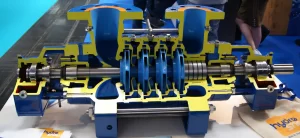The design of pumps plays a critical role in the efficiency of industrial operations. Various factors, such as fluid characteristics and desired flow rates, must be carefully assessed. Inefficiencies, like cavitation, can severely impact productivity. Additionally, advancements in technology present new opportunities for optimization. Understanding these elements is essential for businesses aiming to enhance operations and reduce costs. What specific strategies can be employed to tackle these challenges effectively?
Key Takeaways
- Select materials based on fluid properties to enhance durability and prevent corrosion, ensuring reliable pump performance.
- Align required flow rate and pressure with operational goals to optimize efficiency and reduce costs.
- Implement IoT sensors for real-time monitoring to enable predictive maintenance and minimize downtime.
- Utilize computational fluid dynamics (CFD) simulations to refine pump design and improve hydraulic performance.
- Focus on energy-efficient designs that reduce consumption, lowering operational costs and supporting sustainability initiatives.
Understanding the Importance of Pump Design in Industrial Operations
In the complex landscape of industrial operations, the design of pumps plays a vital role in ensuring efficiency and reliability. Effective pump design is foundational to various applications, influencing not only operational performance but also cost-effectiveness. The selection of materials, dimensions, and configurations directly impacts the hydraulic performance and energy consumption of the system. Furthermore, ideal pump design minimizes maintenance requirements and prolongs service life, which is essential for maintaining continuous operations. By understanding the importance of pump design, companies can align their operational strategies with best practices, ultimately fostering a culture of innovation and growth. This commitment to excellence in pump design considerations for industrial use can remarkably enhance productivity and contribute to the long-term sustainability of industrial enterprises.
Key Factors Influencing Pump Design Considerations for Industrial Use
While various factors contribute to effective pump design, understanding the specific requirements of industrial applications remains paramount. Key considerations include fluid properties, such as viscosity and temperature, which dictate material selection and pump type. Additionally, the required flow rate and pressure must align with operational objectives to guarantee efficiency. Environmental conditions, including potential exposure to corrosive substances or extreme temperatures, also influence design choices. Moreover, system integration is critical; pumps must seamlessly fit within existing infrastructures to optimize performance. Maintenance accessibility is also essential, as it impacts operational uptime. By addressing these factors systematically, businesses can enhance their pump design considerations for industrial use, ultimately driving growth and efficiency in their operations.
Common Challenges in Pump Design and Their Impact on Operations
Effective pump design considerations for industrial use must also address common challenges that can impede operational efficiency. These challenges, if not properly managed, can lead to increased costs, reduced productivity, and potential safety hazards.
- Cavitation – This phenomenon can cause damage to pump components, reducing their lifespan.
- Vibration Issues – Excessive vibrations can lead to mechanical failures and maintenance challenges.
- Fluid Compatibility – Incompatible materials can result in corrosion or leaks, jeopardizing operations.
- Energy Efficiency – Inefficient pumps consume more power, raising operating costs and environmental impact.
Addressing these challenges systematically not only enhances pump performance but also fosters an operational environment conducive to growth and sustainability.
Innovative Solutions for Optimizing Pump Design in Industrial Settings
Numerous innovative solutions exist for enhancing pump design in industrial settings, each aimed at improving efficiency and reliability. Advanced materials, such as composites and corrosion-resistant alloys, improve durability while reducing maintenance costs. Additionally, integrating smart technologies, such as IoT sensors, allows for real-time monitoring of pump performance, facilitating predictive maintenance and minimizing downtime. Computational fluid dynamics (CFD) simulations further enable engineers to refine pump geometries for maximum flow characteristics. Modular designs also offer flexibility, allowing operators to easily upgrade components as needed. By adopting these innovative pump design considerations for industrial use, businesses can achieve significant operational improvements, ensuring sustainable growth and maintaining a competitive edge in their respective markets.
Future Trends in Pump Design Considerations for Enhanced Business Growth
As industries evolve, the future of pump design considerations for enhanced business growth hinges on the integration of cutting-edge technologies and sustainable practices. This evolution will focus on several key areas that can greatly influence operational efficiency and profitability:
- Smart Sensors: Incorporating IoT-enabled sensors for real-time monitoring and predictive maintenance.
- Energy Efficiency: Designing pumps that minimize energy consumption, thereby reducing operational costs.
- Modular Systems: Developing versatile, modular pump designs that allow for easy upgrades and scalability.
- Sustainable Materials: Utilizing eco-friendly materials that enhance durability while reducing environmental impact.
These trends underscore the necessity for businesses to adapt their pump design considerations for industrial use, ensuring alignment with both technological advancements and sustainability goals.
Frequently Asked Questions
What Materials Are Best for Pump Components in Harsh Environments?
In harsh environments, corrosion-resistant materials such as stainless steel, titanium, and specialized alloys are ideal for pump components. These materials enhance durability and performance, ensuring reliability and efficiency in demanding industrial applications over time.
How Can I Determine the Right Pump Size for My Application?
To determine the right pump size for an application, one must assess flow rate requirements, the viscosity of fluids, total dynamic head, and system layout, ensuring ideal performance and efficiency tailored to specific operational demands.
What Maintenance Practices Extend the Life of Industrial Pumps?
Effective maintenance practices, including regular inspections, prompt lubrication, and timely replacement of worn parts, greatly extend the life of industrial pumps. Systematic monitoring of performance metrics also guarantees peak functionality and reduces downtime in operations.
How Do Energy Efficiency Ratings Impact Pump Selection?
Energy efficiency ratings greatly influence pump selection by guiding purchasers toward models that reduce operational costs and environmental impact. Higher ratings typically indicate better performance, leading to long-term savings and enhanced sustainability in industrial applications.
What Are the Costs Associated With Custom Pump Designs?
Custom pump designs incur costs including engineering fees, material selection, manufacturing processes, and testing. These expenses are influenced by specific performance requirements, customization levels, and potential scalability, ultimately impacting overall project budgets and timelines considerably.
Conclusion
To summarize, the design of industrial pumps is a critical determinant of operational efficiency and reliability. By systematically evaluating fluid properties, flow requirements, and environmental conditions, businesses can mitigate challenges such as cavitation and energy inefficiency. The integration of innovative solutions, including smart technology and advanced materials, not only enhances pump performance but also supports sustainability initiatives. As industries evolve, adopting these design considerations will be pivotal in driving productivity and fostering long-term growth.
You May Also Like To Read:


